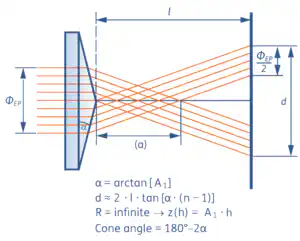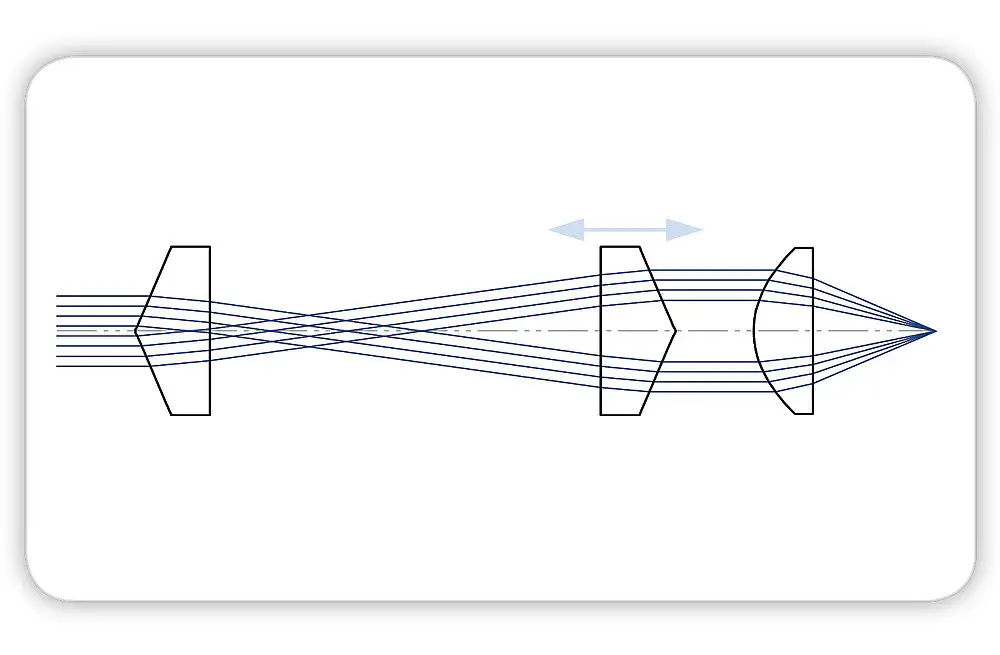
Various beam shaper applications utilizing axicons
Bessel beam shaping and fields of application
Content
Axicons are conical lenses which create a ring-shaped beam used in research or rather different laser applications. They can be either convex or concave and made from almost any optical material. By combining two or more axicons and lenses multiple intensity profiles can be created.
Specifics and Bessel beam creation

Fig. 1) Creation of Bessel beams through an axicon
Axicons are commonly used to create a ring-shaped light distribution (Fig. 1).
A special application is the generation of (non-diffractive) Bessel beams, which are mainly defined by the cone angle (α) of the axicon. Accordingly, for a lot of applications there are two regions of interest:
- firstly, a long region with almost constant intensity distribution (a) and
- secondly a field of ring-shaped intensity distribution (d).
The length (a) depends on the axicon angle (α) and the diameter (ØEP)of the incoming beam, whereas the width of the Bessel beam is regulated by the angle only (Fig. 2). Fig. 1 shows the diameter of the ring-shaped light distribution (d) which depends on the distance (l) and increases with growing distances (l). Thus, the ring width is about half the diameter of the incoming beam

Fig. 2) Dependent relationship between ring width and cone angle
Applications
Axicons are used in research and multiple laser applications which need a ring-shaped intensity profile. They are mainly used in the following areas:
- astronomy
- medicine (e.g., in eye surgery)
- biology
- wave optics.
To generate a collimated ring-shaped beam, to axicons are combined. By varying the distance between both, the ring diameter can be adjusted (Fig. 3). Axicons can also be used in laser eye surgery. Their ability to focus a laser beam into a ring (Fig. 4) is useful in surgery for smoothing and ablating corneal tissue.
Furthermore, axicons are also used in optical trapping. The ring of light (Fig. 5) creates attractive and repulsive forces, which can trap and hold micro particles and cells in the center of the ring.
Another application is the generation of Bessel beams, which length and width can be influenced by the input beam diameter (Fig. 6). To adjust the length and width of the Bessel beam different Beam Expanders can be combined with the axicon.
Spherical aberration is one of the basic imperfections of a spherical lens. It means, that parallel rays of the incoming beam do not find the same focal point after passing a spherical lens. The use of axicons also provide relief here. By modifying the incoming beam to a ring (Fig. 7) the focus of a spherical lens can be improved. This phenomenon can be explained by zonal decomposition of the spherical surface. Illuminating just one ring-shaped zone, the effect of spherical aberration can be avoided. Changing the distance between the axicons, it is possible, to vary the ring-shaped zones and subsequently, to shift the generated spot along the optical axis. Using the same setup to illuminate an aspheric lens will allow focussing below the diffraction limit (Fig. 8).
 8) Improvement of the focal narrowness of an asphere – focusing below the diffraction limit becomes possible.
8) Improvement of the focal narrowness of an asphere – focusing below the diffraction limit becomes possible.
Alignment/tilt
An optical design with a combination of two axicons a perfect collimated ring-shaped beam can be generated. In practical use it is quite challenging to build this constellation. First of all, both axicons need to have a maximum axicon angle deviation within 0.05°. Another point is the alignment of both lenses with a minimum tilt and decentration of both elements. Even small a tilt deviation (> 1 “) will lead to significant distortion of the ring shape.
Using mounted axicons is one possibility to avoid this effect. asphericon developed special mountings with an outer diameter of 30 mm, which can easily be integrated into existing optical systems via adapters. The axicons are perfectly aligned to the optical and mechanical axis and provide comfortable solutions for laser applications. Find out more about mounted optics and adapters in our webshop.
A detailed description of the functionality and the specifics of axicons can be found in our whitepaper, which is available for download here.
Further information
„Beam shaping concepts with aspheric surfaces“ von U. Fuchs, D. Braun und S. Wickenhagen. Erschienen in Proc. SPIE 9581, Laser Beam Shaping XVI, doi:10.1117/12.2186524, September 2015
